01 Day
Specific Tour
Unlimited
English
Looking for a true seaside escape from city stress? Join our Galle Day Tour from Colombo with Lanka Tour Host and experience the best of southern Sri Lanka in one day! This specially designed adventure combines history, nature, culture, and beach charm into a memorable experience — with the convenience of a private chauffeur guide.
You set off on a picturesque drive along the Southern Expressway, with a smooth and quick journey from Colombo to the south coast. Simply get on board a fully air-conditioned vehicle and relax as our professional chauffeur guide welcomes you to the tour highlights.
The iconic image of Sri Lanka’s stilt fishermen at Koggala. They sit on wooden poles in shallow waters — a true one-off view and a leading photo opportunity.
Enjoy a quick retreat at Jungle Beach at Unawatuna, a secluded and serene haven ideal for a quiet walk and ocean breeze. This tropical paradise is lined with dark greens and shining clear water.
Step back into centuries of history as you explore the Galle Dutch Fort, a UNESCO World Heritage property.
Walk along colonial streets, absorbing the Dutch architecture, and browse for charming boutiques, galleries, and cafes within the fort walls.
Discover Sri Lanka’s famous gems with a guided tour of the Gemological Museum.
Indulge in day catches, authentic curries, and tropical juices — all with the stunning ocean view.
Pay tribute to the victims in the Tsunami Photo Museum, a moving reminder of the 2004 Indian Ocean tsunami. See real stories and photos that tell of the resilience of the people of the area.
End your day with a visit to a Turtle Hatchery, where you’ll see how conservationists protect endangered sea turtles. Learn about the life cycle of turtles and even get a chance to see baby hatchlings.
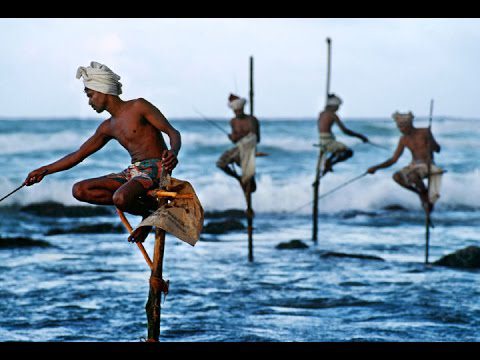
The Weligama Stilt Fishermen are a unique cultural icon of Sri Lanka, particularly famous for their distinctive method of fishing while perched on wooden stilts. Located in the coastal town of Weligama, which translates to "sandy village" in Sinhalese, these fishermen have been practicing their craft for generations.
Stilt fishing is not just a means of livelihood for these fishermen but also a tradition that has been passed down through families, with skills honed over years of experience. The practice itself involves standing on a crossbar attached to a vertical pole that is planted into the seabed, typically at depths where the water is waist-high.
The origins of stilt fishing are believed to date back to World War II when traditional fishing grounds were overcrowded, and resourceful locals sought alternative methods. Over time, it evolved into a cultural practice and a tourist attraction, drawing visitors from around the world who are fascinated by its picturesque and seemingly precarious nature.
The technique requires great balance and patience. Fishermen perch themselves on the stilt for hours, especially during sunrise and sunset when fish are most active near the surface. With a rod in hand and using a simple line and hook setup, they skillfully drop their bait into the water and wait for a catch. The stilts allow them to fish in shallow waters where larger boats cannot navigate, targeting smaller reef fish such as sardines and mackerel.
The sight of Weligama Stilt Fishermen against the backdrop of the Indian Ocean is not only visually striking but also a poignant reminder of the intimate relationship between the people of Sri Lanka and the sea. It has become a symbol of resilience and adaptability, as these fishermen continue to practice their age-old tradition amidst changing times and modern fishing practices.
However, like many traditional practices, stilt fishing faces challenges such as declining fish stocks and economic pressures. Despite this, efforts are being made to preserve and promote this cultural heritage. Many fishermen now supplement their income by posing for photographs with tourists, which has become a source of income alongside their traditional fishing.
In conclusion, the Weligama Stilt Fishermen embody a blend of tradition, skill, and cultural identity that continues to captivate and inspire both locals and visitors alike. Their perseverance in maintaining this unique fishing method serves as a testament to the enduring spirit of Sri Lanka's coastal communities.
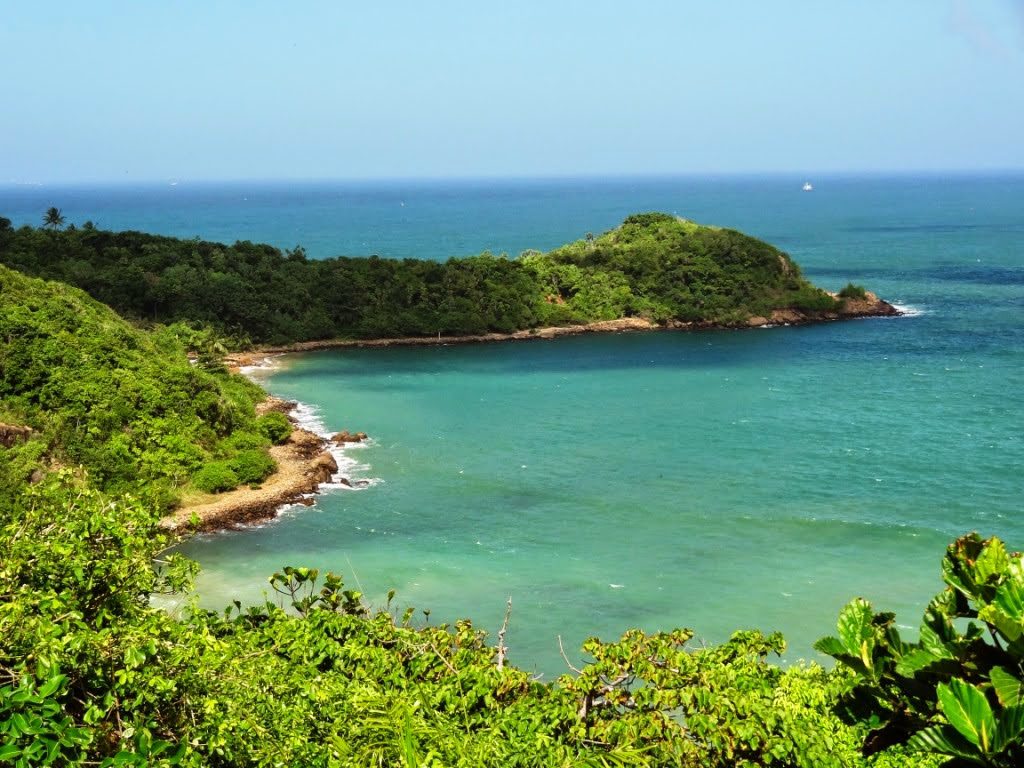
Jungle Beach is a secluded and picturesque destination located near Unawatuna in southern Sri Lanka, renowned for its natural beauty and tranquil atmosphere. Nestled amidst lush greenery and accessible via a short hike through a tropical jungle, Jungle Beach offers visitors a serene escape from the bustling nearby towns.
Here's what makes Jungle Beach a special place:
Scenic Beauty: Surrounded by dense foliage and nestled along a pristine coastline, Jungle Beach captivates visitors with its natural charm. The beach itself is small but stunning, with soft golden sand contrasting against the turquoise waters of the Indian Ocean.
Seclusion and Serenity: One of the main draws of Jungle Beach is its secluded nature. Unlike more popular beaches in the area, Jungle Beach remains relatively uncrowded and offers a peaceful environment ideal for relaxation and unwinding.
Snorkeling and Swimming: The clear waters of Jungle Beach are perfect for snorkeling and swimming. Visitors can explore vibrant coral reefs teeming with colorful marine life just a short distance from the shore. Snorkeling gear is available for rent, allowing both beginners and experienced snorkelers to enjoy the underwater wonders.
Nature Trails: To reach Jungle Beach, visitors can embark on a short but pleasant trek through the jungle. The trail is shaded by towering trees and offers glimpses of various bird species and other wildlife, adding to the adventure of the journey.
Sunset Views: The westward-facing orientation of Jungle Beach provides breathtaking sunset views over the ocean. The tranquil setting and the changing colors of the sky make it a popular spot for photography and romantic moments.
Facilities and Amenities: Despite its remote location, Jungle Beach offers basic amenities such as beach chairs, umbrellas, and a small café where visitors can enjoy refreshments and snacks.
Environmental Conservation: Efforts are made to preserve the natural beauty of Jungle Beach and its surroundings. Visitors are encouraged to respect the environment and take their litter with them, contributing to the conservation efforts of this pristine coastal ecosystem.
Overall, Jungle Beach is a hidden gem that appeals to travelers seeking a quieter and more intimate beach experience in Sri Lanka. Whether you're looking to snorkel among vibrant reefs, unwind on a secluded shore, or simply immerse yourself in the beauty of nature, Jungle Beach offers a memorable escape into tranquility and natural splendor.
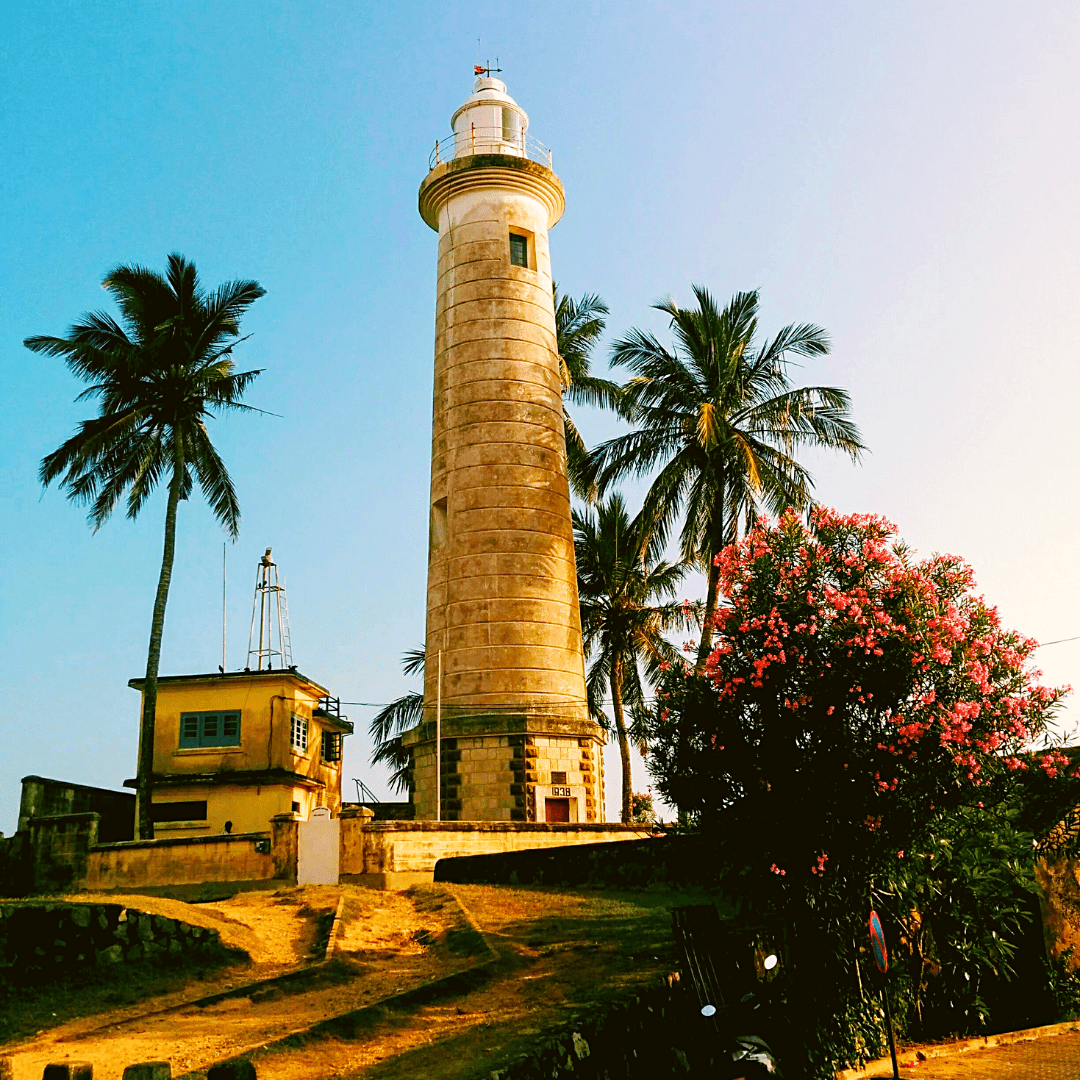
Galle Fort is a UNESCO World Heritage Site located in the historic city of Galle, along the southern coast of Sri Lanka. Steeped in history and cultural significance, Galle Fort stands as a testament to the island's colonial past and its strategic importance in maritime trade routes.
Here are key features and highlights of Galle Fort:
Historical Background: The fort was originally built by the Portuguese in the late 16th century, later fortified extensively by the Dutch during the 17th century, and further modified by the British during their colonial rule. This layered history is reflected in its architecture and layout, blending European colonial styles with South Asian traditions.
Architecture and Layout: Galle Fort is characterized by its sturdy ramparts, bastions, and impressive gateways. The fortifications encircle a compact area of narrow streets lined with colonial-era buildings, churches, mosques, and warehouses. The architecture includes Dutch-style buildings with characteristic red-tiled roofs, reflecting the influence of the Dutch East India Company.
Cultural Diversity: Within Galle Fort, there is a vibrant mix of cultures and communities. The fort has historically been home to Sri Lankan Sinhalese, Tamil, Muslim, Dutch, Portuguese, and British residents, each leaving their mark on its culture and architecture.
Landmarks and Attractions: Key landmarks within Galle Fort include the Galle Lighthouse, which offers panoramic views of the ocean and fort, the Dutch Reformed Church with its imposing architecture and historic cemetery, and the Dutch Hospital complex now converted into a charming precinct of boutiques, cafes, and galleries.
Shopping and Dining: The streets of Galle Fort are dotted with boutique shops selling antiques, jewelry, clothing, and local handicrafts. Visitors can also enjoy a variety of dining options ranging from quaint cafes to elegant restaurants serving both local and international cuisine.
Art and Culture: Galle Fort is a hub of artistic and cultural activities, hosting art galleries, exhibitions, music festivals, and theatrical performances throughout the year. The fort's unique ambiance and historical backdrop provide an inspiring setting for creative expression.
Community and Conservation: Today, Galle Fort is not only a major tourist attraction but also a thriving community where residents continue to live and work. Efforts are made to preserve its heritage and maintain its architectural integrity, ensuring its legacy for future generations.
Visiting Galle Fort offers a glimpse into Sri Lanka's colonial past, showcasing a blend of history, culture, and architectural beauty. Whether exploring its ramparts at sunset, strolling through its charming streets, or discovering its cultural treasures, Galle Fort provides a memorable experience steeped in centuries of maritime history and cultural exchange.

Sri Lanka is renowned worldwide for its rich gemstone heritage, particularly its exquisite Blue Sapphires, making it a destination of choice for gem enthusiasts and collectors. The island nation has a long history of gem mining and trading, dating back over 2,500 years. Gems are not just prized for their beauty but also for their cultural significance and economic value.
Among Sri Lanka's gemstones, the Blue Sapphire holds a special place. Known for its deep, velvety blue hue, Sri Lankan Blue Sapphires are highly sought after for their exceptional clarity and brilliance. The sapphires are found mainly in alluvial deposits in river beds and are carefully mined using traditional methods to preserve their quality.
Sri Lanka's Blue Sapphires have adorned the crowns and jewelry of royalty and nobility throughout history. One notable example is the engagement ring worn by Princess Diana and later passed down to Catherine, Duchess of Cambridge, which features a stunning Sri Lankan Blue Sapphire surrounded by diamonds.
Visiting a gem museum in Sri Lanka offers a fascinating journey into the world of gemstones. These museums showcase not only a dazzling array of gemstones but also educate visitors about the geological processes, mining techniques, and craftsmanship involved in creating fine jewelry. The exhibits often include raw gemstones, polished gems, historical artifacts, and displays on Sri Lanka's gem industry.
Sri Lanka's gem mining industry is centered around several key regions, including Ratnapura (City of Gems) and the areas surrounding Kandy and Galle. Traditional methods such as hand mining and panning are still practiced in some areas, maintaining a connection to ancient techniques.
The island is blessed with a variety of gemstones besides Blue Sapphires, including:
The Sri Lankan government and local communities are actively involved in sustainable gem mining practices and conservation efforts to protect the island's natural resources. This includes initiatives to promote ethical mining practices, support local communities dependent on gem mining, and ensure fair trade practices in the gem industry.
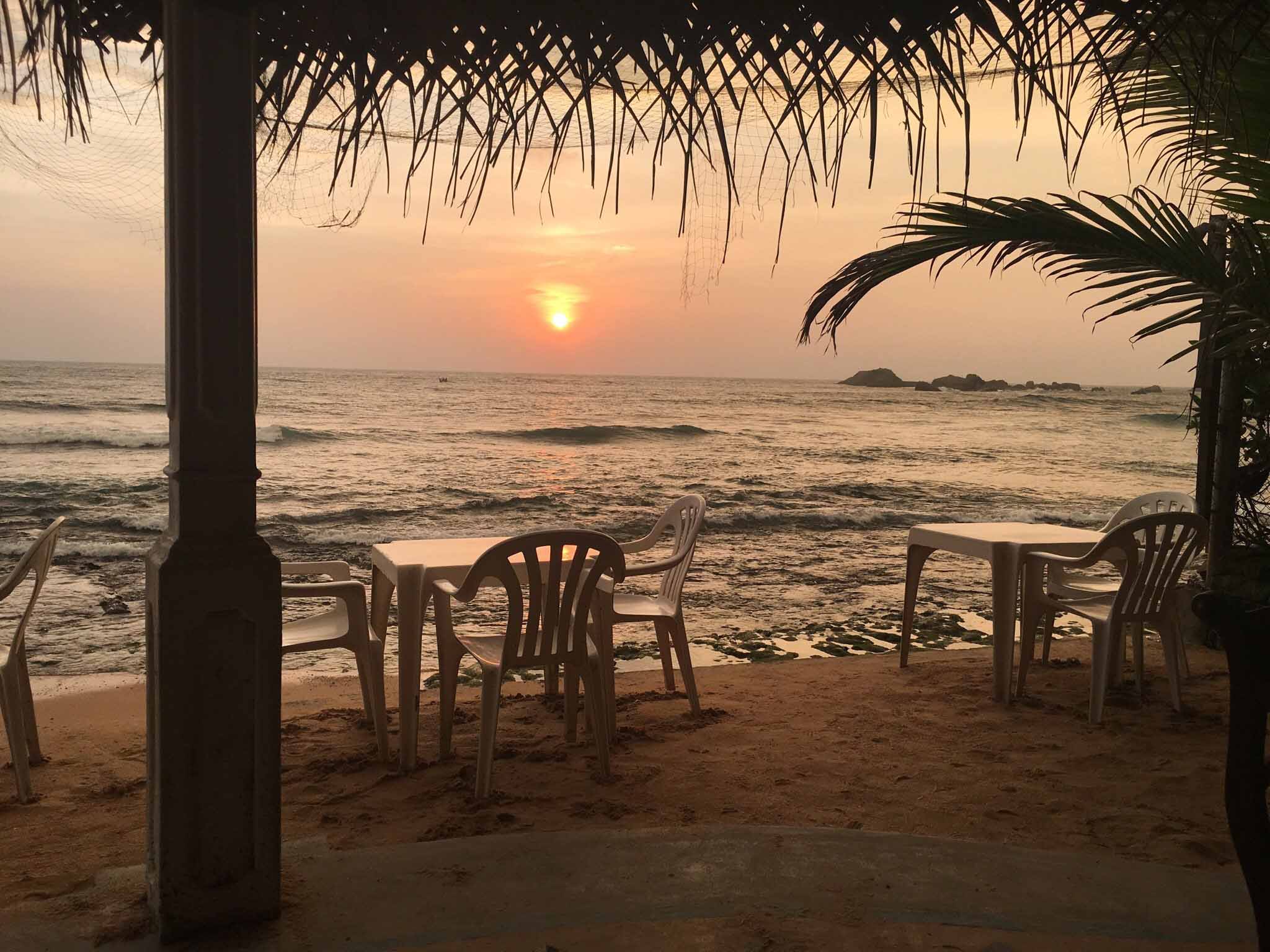
Lunch at a beach restaurant in Hikkaduwa offers a delightful combination of fresh seafood, tropical ambiance, and stunning ocean views, making it a memorable culinary experience. Hikkaduwa, located on Sri Lanka's southwest coast, is renowned for its lively beach scene and vibrant culinary offerings.
Imagine arriving at a beachfront restaurant in Hikkaduwa, greeted by the sound of crashing waves and the gentle sea breeze. The restaurant is typically designed to maximize ocean views, with open-air seating that allows you to feel the sand beneath your feet and soak in the sun's warmth.
One of the highlights of dining at a beach restaurant in Hikkaduwa is the abundance of fresh seafood. Sri Lanka's coastal waters are rich in a variety of fish, prawns, crabs, and lobsters, which are skillfully prepared and served in various mouthwatering dishes. You might start with a seafood platter featuring grilled prawns, calamari, and fish skewers, accompanied by tangy lime or spicy chili sauce.
In addition to seafood, Hikkaduwa's beach restaurants often serve traditional Sri Lankan cuisine, known for its bold flavors and aromatic spices. You can indulge in dishes like fragrant rice and curry, where an array of curries ranging from creamy coconut milk-based to fiery chili-infused varieties are served with fluffy rice and accompaniments like sambols (spicy condiments) and papadums (crispy lentil wafers).
To complement your meal, tropical drinks are a must. Sip on fresh fruit juices, coconut water straight from the husk, or indulge in a refreshing king coconut, known locally as "thambili." For those looking to unwind, beach restaurants often offer a selection of local beers, cocktails, and mocktails featuring tropical fruits and herbs.
The ambiance of a beach restaurant in Hikkaduwa is laid-back and inviting, perfect for unwinding and enjoying the slower pace of coastal life. You can dine under palm-thatched umbrellas or directly on the beach, watching surfers catch waves in the distance or local fishermen bringing in their daily catch.
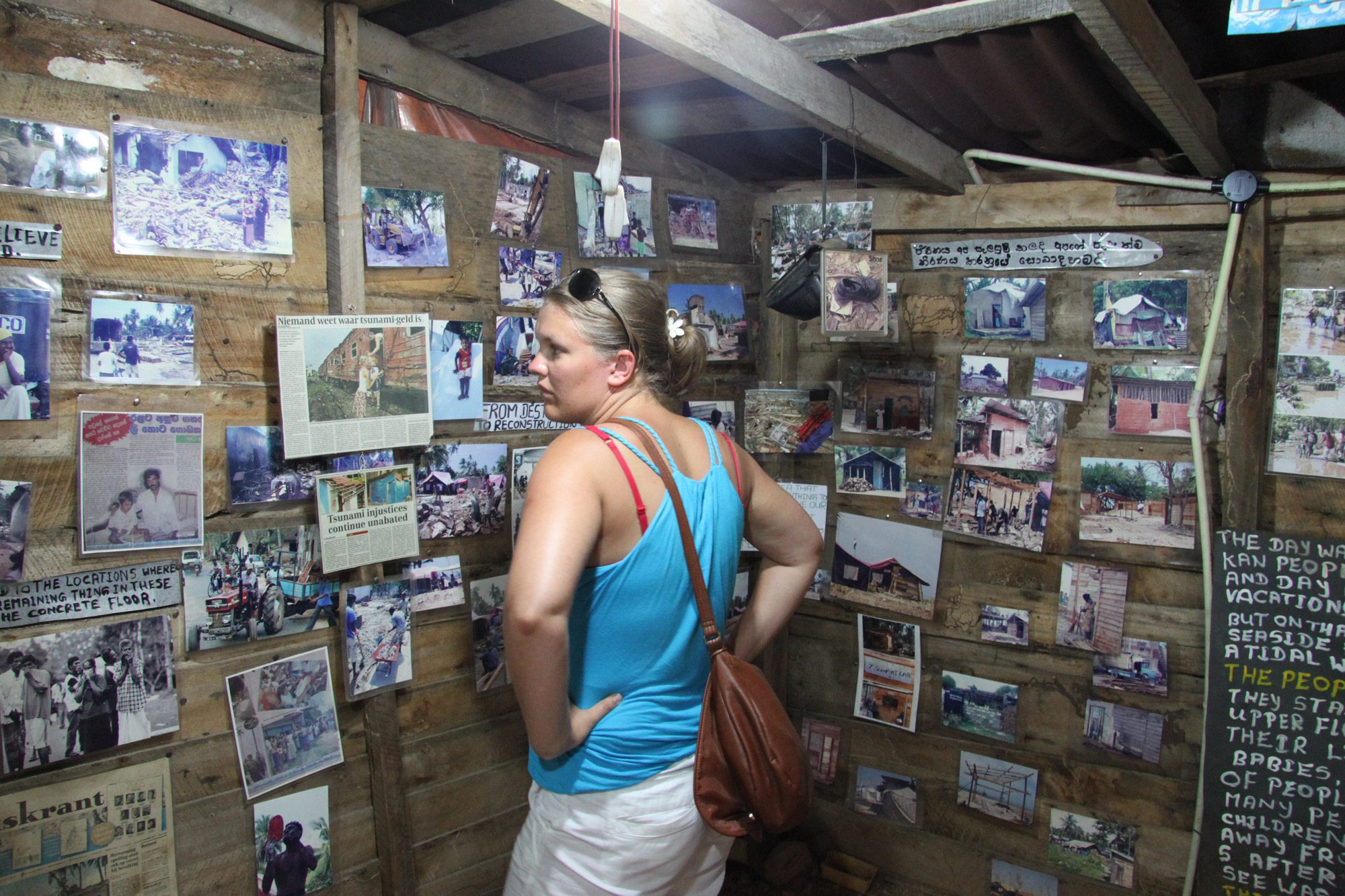
The Tsunami Photo Museum features an extensive collection of photographs and personal artifacts that document the events before, during, and after the tsunami. The exhibits include:
Photographs: These visual records capture the sheer force of the waves, the immediate aftermath, and the widespread destruction caused by the tsunami. They also depict the heart-wrenching moments of loss and the extraordinary efforts of rescue and relief operations.
Personal Stories: The museum displays personal accounts from survivors, offering a deeply human perspective on the disaster. These narratives highlight the experiences of individuals and families who endured unimaginable loss and demonstrate their strength and determination to rebuild their lives.
Artifacts: Items recovered from the wreckage, such as household objects, clothing, and remnants of the Queen of the Sea train, provide tangible connections to the event. These artifacts serve as powerful reminders of the lives disrupted and the enduring impact of the tsunami.
Educational Material: The museum also includes informational displays about tsunamis, their causes, and the science behind these natural disasters. This educational aspect aims to raise awareness about tsunami preparedness and the importance of early warning systems.
The Tsunami Photo Museum is not only a place of remembrance but also a center for education and awareness. It plays a crucial role in preserving the memory of the tragedy, honoring the victims, and highlighting the resilience of the survivors. The museum also serves as a platform to educate the public about natural disaster preparedness, emphasizing the need for vigilance and community solidarity in the face of such events.
The museum is a community-driven initiative, supported by local residents and volunteers who are dedicated to preserving the history and lessons of the 2004 tsunami. Their efforts ensure that the museum remains a vibrant and meaningful tribute to those affected by the disaster.
In conclusion, the Tsunami Photo Museum in Telwatta stands as a testament to the human spirit's resilience and the collective efforts to remember and learn from one of the most devastating natural disasters in recent history. It offers visitors a chance to reflect on the past, understand the power of nature, and recognize the importance of preparedness and community support in mitigating the impact of future disasters.
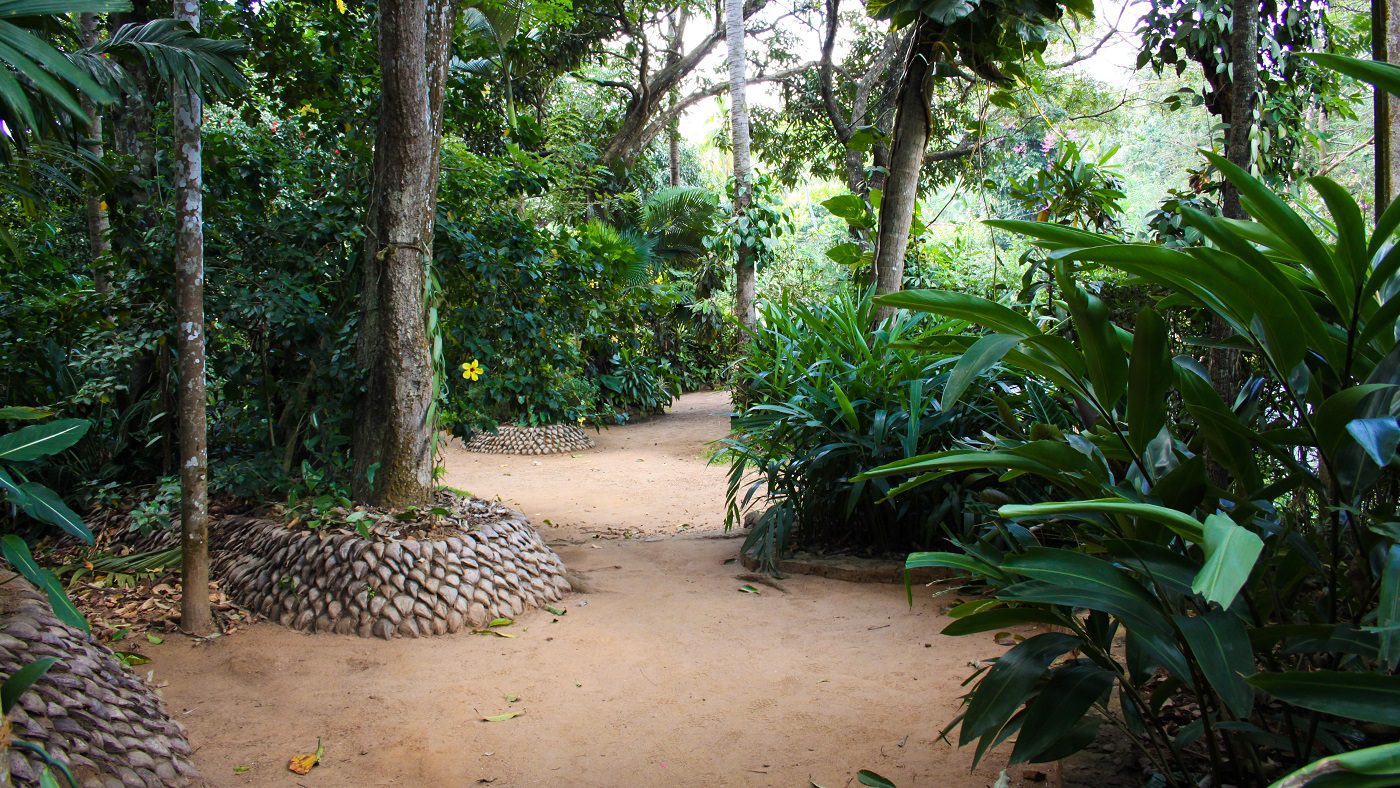
The Spice and Herbal Garden in Meetiyagoda, Sri Lanka, is a serene and educational destination that showcases the rich botanical heritage of the region. Nestled in the lush countryside, this garden is a haven for plant enthusiasts, tourists, and those interested in traditional herbal medicine.
Meetiyagoda, a village known for its moonstone mines, is also home to this vibrant spice and herbal garden. The garden is a reflection of Sri Lanka's long-standing tradition of using spices and herbs, both in cuisine and traditional Ayurvedic medicine.
Spice Cultivation: The garden features a variety of spices that are integral to Sri Lankan cooking. Visitors can see, smell, and learn about spices such as cinnamon, cardamom, cloves, nutmeg, and black pepper. The cultivation methods and the history behind each spice are explained by knowledgeable guides.
Herbal Plants: In addition to spices, the garden hosts a wide array of medicinal herbs. Plants like aloe vera, neem, turmeric, and gotu kola are some of the highlights. These herbs are known for their therapeutic properties and play a significant role in Ayurvedic practices.
Guided Tours: Expert guides offer comprehensive tours of the garden, providing insights into the uses and benefits of various plants. They explain the traditional methods of processing and utilizing these herbs and spices, which have been passed down through generations.
Demonstrations and Workshops: The garden often conducts demonstrations on how to prepare herbal remedies and spice-based products. Visitors can learn how to make traditional herbal balms, oils, and even spice blends that are used in cooking.
On-site Shop: There is usually an on-site shop where visitors can purchase spices, herbal products, and natural cosmetics. These items are often organically grown and processed on-site, ensuring high quality and authenticity.
The Spice and Herbal Garden in Meetiyagoda serves as an important educational resource, promoting awareness about the benefits of natural and sustainable farming practices. It underscores the significance of traditional knowledge in modern times, especially in the fields of health and wellness.
The garden provides a tranquil environment where visitors can reconnect with nature. The lush greenery and aromatic air create a soothing ambiance, making it a perfect spot for relaxation and learning.
The garden also plays a role in supporting the local economy. By attracting tourists and promoting the sale of locally produced spices and herbal products, it helps sustain the livelihoods of many in the community.
In conclusion, the Spice and Herbal Garden in Meetiyagoda is a wonderful destination for anyone interested in the rich botanical traditions of Sri Lanka. It offers a unique opportunity to explore the world of spices and herbs, learn about their uses and benefits, and appreciate the importance of preserving this valuable heritage.
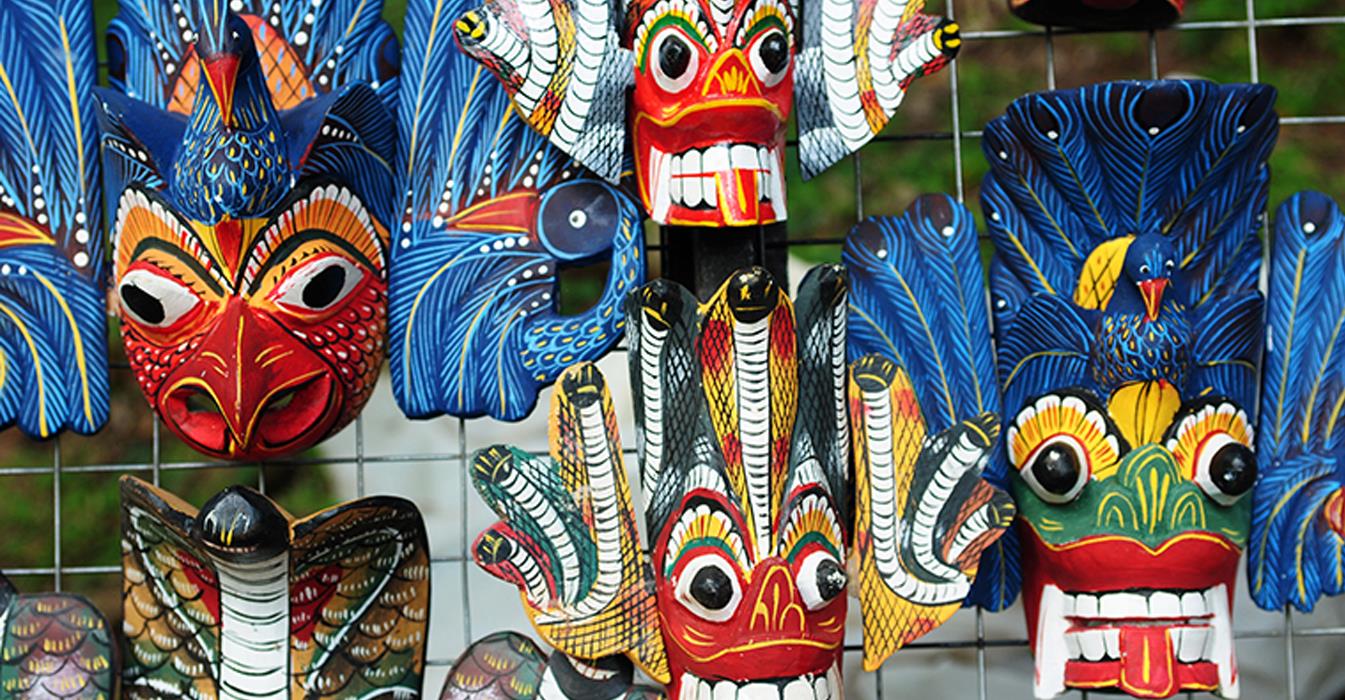
The Mask Factory in Ambalangoda, Sri Lanka, is a vibrant testament to the island's rich cultural heritage and craftsmanship. Ambalangoda, located on the southwestern coast of Sri Lanka, is renowned for its traditional mask-making, an art form deeply rooted in the region's history and folklore.
The tradition of mask-making in Ambalangoda dates back centuries and is closely tied to Sri Lankan rituals, festivals, and theatrical performances. Masks are integral to various traditional dances, such as Kolam, Sanni, and Raksha, each with its own unique significance and style. These performances often depict ancient legends, folk tales, and socio-political themes, using masks to personify different characters, demons, and deities.
Visiting a mask factory in Ambalangoda offers a fascinating glimpse into this ancient craft. The factory is typically a blend of workshop and exhibition space, where artisans create, display, and sell their intricate works.
Design and Carving: The process begins with designing the mask, which involves sketching the desired character or motif. Artisans then carve the mask out of lightweight wood, traditionally from the kaduru tree (Nux vomica). This wood is favored for its softness and ease of carving.
Smoothing and Shaping: After carving, the mask is smoothed and shaped using various tools to achieve the desired details and features. This stage requires meticulous attention to detail and significant skill.
Painting and Decoration: Once the carving is complete, the mask is painted with vibrant colors. Natural dyes and paints are often used to achieve the bright hues that characterize traditional masks. Additional decorations, such as beads, feathers, and fabrics, may be added to enhance the mask's appearance.
Kolam Masks: Used in Kolam dances, these masks are often humorous and depict characters from rural life and folklore, including kings, queens, and jesters.
Sanni Masks: These masks are used in the Sanni Yakuma ritual, a traditional healing ceremony. Each mask represents a specific ailment or demon, believed to cause various illnesses.
Raksha Masks: These masks represent mythical creatures and demons, often with fierce and exaggerated features. They are used in Raksha dances to ward off evil spirits.
The masks of Ambalangoda are not just artistic creations but also cultural artifacts that play a crucial role in preserving Sri Lankan traditions and rituals. They are symbols of the island's rich heritage and continue to be a significant aspect of its cultural identity.
Many mask factories offer interactive experiences for visitors. These may include:
The mask factories in Ambalangoda also contribute to the local economy. They provide employment to skilled artisans and promote cultural tourism, attracting visitors from around the world. The sale of masks and other handcrafted items supports the livelihoods of many local families.
In conclusion, the Mask Factory in Ambalangoda is a cultural treasure that offers a captivating look into Sri Lanka's artistic and ritualistic traditions. It is a place where history, art, and culture come together, providing a unique and enriching experience for visitors.
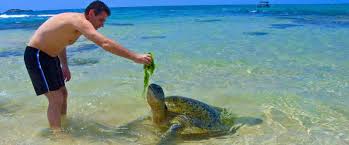
The Victor Hasselblad Turtle Hatchery in Kosgoda, Sri Lanka, is a significant conservation initiative dedicated to the protection and preservation of sea turtles. Named after the renowned Swedish photographer Victor Hasselblad, whose foundation has supported numerous environmental projects, this hatchery plays a crucial role in safeguarding these endangered marine creatures.
Kosgoda is a coastal town on the southwestern coast of Sri Lanka, renowned for its beautiful beaches and rich biodiversity. The Victor Hasselblad Turtle Hatchery, established in the late 1970s, is one of the many hatcheries in the area but stands out for its long-term commitment to turtle conservation and education.
The primary objective of the hatchery is the conservation of sea turtles, particularly the five species that visit Sri Lankan shores: the Green Turtle, Hawksbill Turtle, Olive Ridley Turtle, Loggerhead Turtle, and Leatherback Turtle. The hatchery focuses on several key activities:
Egg Collection and Incubation: To protect turtle eggs from poaching and natural predators, the hatchery staff collects eggs from nesting sites along the beach. These eggs are then carefully relocated to secure incubation areas within the hatchery, where they are monitored until they hatch.
Hatchling Release: Once the eggs hatch, the hatchlings are kept in a protected environment for a short period before being released into the sea. This practice increases their chances of survival by ensuring they are strong enough to navigate the ocean currents and evade predators.
Rescue and Rehabilitation: The hatchery also rescues injured or sick turtles, providing them with medical care and rehabilitation until they are fit to be released back into the wild. This includes treating turtles that have been caught in fishing nets or affected by pollution.
Educating the public about sea turtle conservation is a crucial aspect of the hatchery’s mission. They offer several educational initiatives:
Guided Tours: Visitors can take guided tours of the hatchery, where they learn about the life cycle of sea turtles, the challenges they face, and the conservation efforts being undertaken. Knowledgeable guides provide detailed explanations and answer questions.
School Programs: The hatchery collaborates with local schools to educate students about marine conservation. These programs aim to foster a sense of responsibility and stewardship for the environment among young people.
Community Engagement: The hatchery works with local communities to promote sustainable fishing practices and reduce the impact of human activities on turtle populations. Engaging local fishermen and residents in conservation efforts is essential for long-term success.
Visiting the Victor Hasselblad Turtle Hatchery is a rewarding experience that offers a chance to witness conservation efforts firsthand. Highlights of a visit may include:
The hatchery’s work has a significant positive impact on the local marine ecosystem. By increasing the survival rates of hatchlings and rescuing injured turtles, the Victor Hasselblad Turtle Hatchery contributes to the preservation of sea turtle populations, which are crucial for maintaining healthy marine environments.
The hatchery relies on donations, grants, and revenue from tourism to fund its operations. The Victor Hasselblad Foundation's support has been instrumental in ensuring the hatchery’s sustainability and expanding its conservation efforts.
In conclusion, the Victor Hasselblad Turtle Hatchery in Kosgoda is a vital conservation project dedicated to protecting sea turtles and educating the public about the importance of marine conservation. It stands as a beacon of hope for the future of these endangered species and offers visitors a unique and meaningful way to engage with wildlife conservation efforts.
The Galle Day Tour includes transportation, a professional guide, entrance fees to all listed attractions, and a delicious seafood lunch at a local restaurant.
The Galle Day Tour usually lasts around 8-10 hours, including travel time to and from Galle.
The tour covers major attractions in Galle, such as the Galle Fort, Dutch Reformed Church, Galle Lighthouse, Maritime Archaeology Museum, and the local Galle Market.
Yes, all entrance fees to the listed attractions are included in the tour price.
No, beverages are not included with lunch. You can be purchased separately at the restaurant.
It's recommended to bring comfortable clothing, good walking shoes, sunscreen, a hat, and a camera to capture the beautiful sights.
Yes, the tour is suitable for children and elderly guests. The tour involves moderate walking, so please consider individual mobility and stamina.
You can book the tour through the Lanka Tour Host website or contact their customer service directly for reservations.
The cancellation policy varies, so please refer to the specific terms and conditions provided at the time of booking or on the Lanka Tour Host website.
| # | Discount group | From adult | To adult | Value |
|---|---|---|---|---|
| 4 | 03 Pax | 03 | 03 | 10% |
| 5 | 04 Pax | 04 | 04 | 20% |
| 6 | 05 Pax | 05 | 05 | 35% |